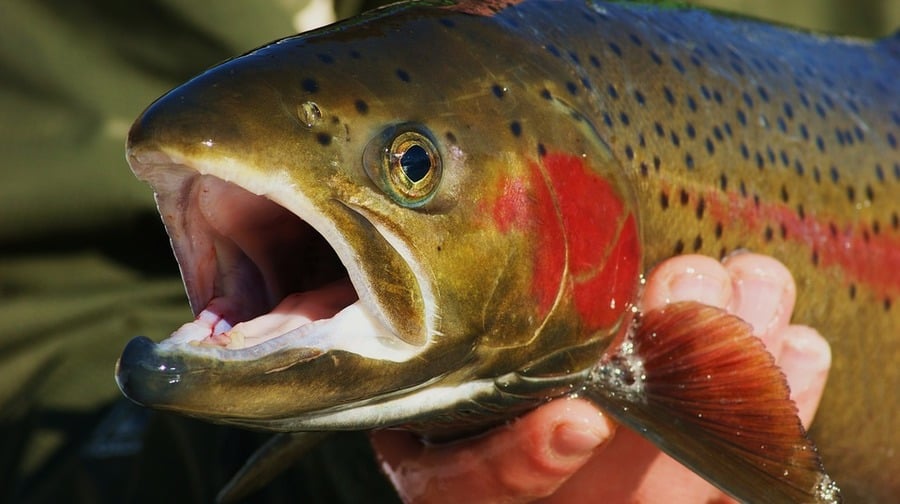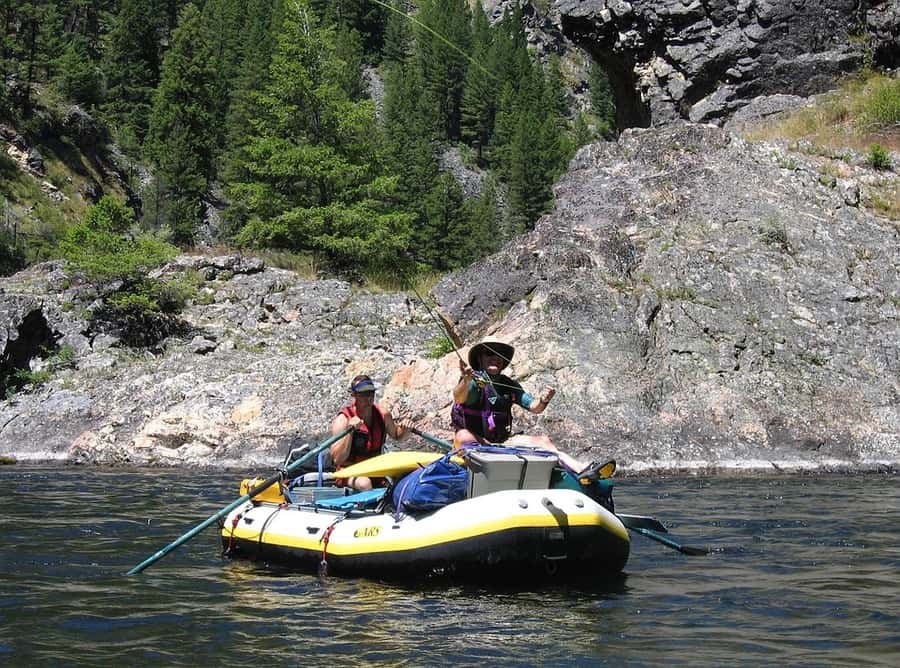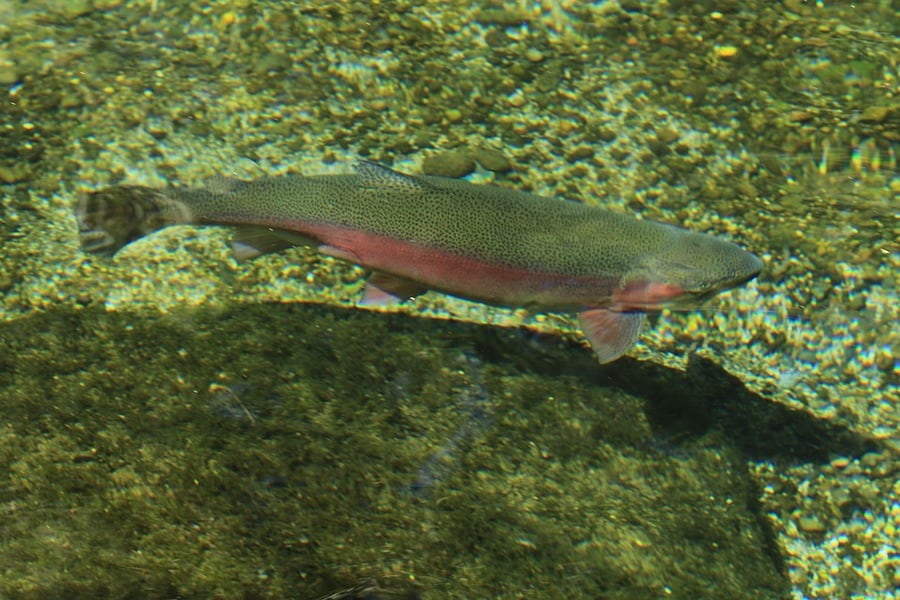4 Best Ways to Catch Trout in Any Type of Water & Season – Freshwater Fishing Advice

Trout fishing is one of the most popular outdoor activities in North America. There are a variety of ways to fish for trout, but in this article, I will explain the best ways to catch trout. Each of these methods has their ideal conditions and advantages.
What’s the best way to catch trout? When fishing for trout in moving water like streams and rivers, fly fishing is the best way to catch trout consistently. When fishing in lakes and reservoirs, trolling or jigging artificial baits like spoons and jigs will be the most successful strategy for trout.
Fly fishing offers fishermen the most flexibility and adaptability of any fishing method when it comes to fishing for brook trout, rainbow trout, brown trout, and cutthroat trout.
Artificial flies most closely mimic natural bait and can be tailored directly to what trout are currently eating on a moment-to-moment basis. As long as you are willing to change your rod and approach, fly fishing is equally successful in small streams and large rivers.
When it comes to fishing in slow-water situations like ponds, lakes, and reservoirs, fly fishing can work but you are better off using artificial lures for trolling or jigging.
Trout in lakes can be notoriously tough to locate since they are constantly wandering and are often not as tightly associated with prominent cover as some.
I know this is a bit random, but if you ever wanted to go on a guided or chartered fishing trip in freshwater or saltwater, you should check out Fishing Booker. They are the leading database of certified and professional fishing guides at the guaranteed lowest prices.
They have countless listings for such dream destinations as the Florida Keys, Corpus Christi, Great Lakes, San Diego, Central America, Montana, and many more. Click here to visit Fishing Booker and book your trip of a lifetime at very affordable prices.
Best Ways to Catch Trout
Best Way to Catch Trout in Streams & Rivers
1. Small Streams
When fishing for trout in small streams, you will usually be dealing with quick-moving, shallow-water. Small mountain streams are often well-shaded by overhead trees.
You likely won’t catch many large trout out of these streams but they can be excellent for small and medium-sized native trout species. They can also be just as rewarding for fly fishermen to fish as larger streams.
The two best ways to catch mountain stream trout is fly fishing and bait fishing. As bait, go with sweet corn, worms, grasshoppers, and small baitfish. Fly fishing can be amazing in these streams especially nymphs and dry flies.
Look for slower pockets of water like eddies and bank undercuts where the water is deeper and slow-moving. Bigger trout will congregate in these pockets facing the current.
2. Large Streams/Small Rivers

When fishing small rivers, live bait on a spinning rod setup can be very effective. Go with worms, corn, and small minnows. Fly fishing is even better. Fly fishing is the best way to fish for trout in large streams or small rivers. If you have waders, accessing prime trout habitat is very realistic.
When fishing in a river, go with a 5 weight fly rod with fast or medium action. This size rod is the most versatile size trout rod out there capable of handling trophy trout along with tiny mountain brook trout.
Dry flies work really well if you witness trout rising to the surface. More often, nymphs and egg-patterns will be your best bet.
I really like San Juan worms in this situation. In larger bodies of water like this, you can start experimenting with streamers for bigger brown and rainbow trout.
3. Big Rivers
When fishing in large rivers, fly fishing can work but you are much better off treating large rivers like lakes and reservoirs. Casting and trolling artificial lures is the best way to locate and catch these trout.
I recommend strongly using downriggers to deliver your lures deep against the force of the current. You can also use planer boards to get your baits out far from the boat and use more rods.
Great lures in single-hook spoons, spinners, and plugs. I think trolling is the best way to fish for trout in big rivers but fly fishing and casting lures can work well too.
For a complete breakdown of everything you need for trout fishing, click here for my comprehensive trout fishing gear list. I’ll tell you what fly rods, spinning rods, flies, castable fish finders, and waders you need to be more successful than anyone else on the water.
Best Way to Catch Trout in Lakes & Reservoirs
When fishing in lakes and reservoirs, the hardest part about fishing for trout is locating fish. You can oftentimes catch trout from shore but this may require a lot of trial and error to find the good fishing spots. You can fly fish or cast lures from shore with some success if the trout are holding close to the bank.
More likely is that trout will be dispersed much further from shore and a boat is required to access them. Fish near points, the mouths of rivers, and along deep channels to locate big rainbow trout as well as lake trout.
These are good starting spots but reservoir trout seem to be pretty transient and can wander throughout the lake all day long.
Another key thing to remember is trout will often suspend mid-way up the water column as they move. A great idea is to locate schools of shad or shiners which can often be found with big trout trailing behind.
To locate trout in lakes, it may require you to troll spoons and spinners for hours before getting bit. Once you get your first hit, mark the spot and start jigging and casting lures over that zone.
If the fish are down deep, jig for them with spoons or jigs. If they are up closer to the surface, use casting spoons, spinners, and plugs to target these trout.
What is the Best Way to Catch Winter Trout?
When fishing in the winter, jigging small baits through the ice is the best way to catch trout. This option is available to anyone in a state that experiences cold enough winters for ice cover.
While you can catch small lake trout through the ice, the two species of trout we will focus on in this section are brook trout and rainbow trout.
How To:
When ice fishing for winter trout, it is important to dig a lot of holes. Trout can be notoriously tough to locate in lakes. This can be extremely frustrating with folks without a gas-powered ice auger.
Speaking from experience, it can be very disheartening to spend 10-20 minutes digging a single hole only to realize there are no fish where you chose. For that, I recommend you invest in a power auger since trout fishing can be almost entirely location-based.
You are either on a school of trout or you aren’t. Bait selection is not as important for ice fishing trout as location is.
A good place to start digging holes is where you believe the water will be 6-20 feet deep. A good strategy is to observe the topography around the lake as a cue for water depth.
Water depth and slopes usually mimic land topography along the shoreline. For example, if the land on one side of the lake is flat, you can bet the water will be shallow and be gently sloping.
On the other hand, if the bank side is very steep, you can be assured the water will be deep with a very steep underwater slope.
Trout do like certain features in lakes. Islands and points near a dropoff are great locations to start. As far as jigging is concerned, I feel like small jigheads tipped with a small minnow, mealworms, or wax worms work really well. Many fishermen have success with small jigging spoons and spinners.
The second best way of catching winter trout is fly fishing on small rivers. This can work great for river brook trout, rainbows, and brown trout. Some trophy river trout are caught during the winter when few fishermen are on the water.
Streamers and nymphs seem to work the best on most winter days. On warmer days, dry flies could be your ticked to success. Make sure you bundle up as even wearing thick neoprene waders, the cold moving water will chill you fast.
Why is Fly Fishing So Effective for Trout?
If I had to fish for trout and only use one technique for the rest of my life, I would become a fly fisherman. Fly fishing is a technical fishing method which requires specialized gear and acquired skills.
But no fish lends itself more heavily to fly fishing than trout. Fly fishing is best for fishing small streams and large rivers which is exactly the habitat trout choose.
The diet of trout, especially rainbow trout, cutthroats, brook trout, and brown trout is especially aligned with fly fishing. Trout eat an insect and aquatic invertebrate-heavy diet.
They readily consume midges, nymphs, larval insects, mayflies, dragonflies, bees, horseflies, grasshoppers, crayfish, freshwater shrimp, and many other species.
Rainbow trout also heavily gorge on salmon eggs immediately after salmon runs in certain coastal rivers. Trout also eat small baitfish like sculpins, minnows, dace, and smelt. All of these baits are reproduced in countless fly patterns and choices available to studious fly fishermen.
It is this diet coupled with a trout’s eagerness to feed both off the bottom and at the surface which is why fly fishing is so effective for trout fishing. Fly fishing is not the only way of catching trout but if I had to choose one method, it would be fly fishing.
Can you Catch Trout Without Fly Fishing?
Of course you can catch freshwater trout without fly fishing. Fly fishing is merely one way of catching trout, albeit a very effective way.
You could also catch trout by trolling, drift fishing with live bait, casting artificial lures, and vertically jigging baits. Each of these methods certainly has its best times and occasions which I covered earlier in this article.
The bottom line is there are a variety of methods for trout fishing that works really well. In the long-run, fly fishermen will have the best success for trout but any of these methods work really well when the conditions are right.
Species Breakdown: Best Methods for Catching Trout
Brook Trout
Brook trout are often stocked in lakes but you are most likely to encounter them in cool, quick-moving mountain streams. To fish for stream brook trout, it is best to either use live bait (if permitted) or fly fishing. If using live bait, worms, minnows, mealworms, small crayfish, and grasshoppers are ideal.
To locate brook trout, look for pockets or slower, deeper water off the main current. Trout like to position themselves in eddies under bank undercuts that are fed by the current.
This well-oxygenated water allows them to rest out of the main current but position themselves to grab food as the current pushes it by.
Cutthroat Trout
There are a variety of subspecies of cutthroat trout native to the Rocky Mountain and Pacific Coastal states. These species of trout are arguably the most beautiful of the all the American trout.
Cutthroat trout used to be much more widespread but the introduction of more aggressive trout like brook trout, brown trout, lake trout, and rainbow trout have pushed cutthroat trout into more fringe-locations often higher up into alpine streams.
There are still some large-growing cutthroat like the Lakota cutthroat in Nevada/CA and the Yellowstone cutthroat in NW Wyoming that inhabit lakes and low-lying streams. It seems the majority of cutthroat species are best targeted in steeper-gradient streams at higher elevation.
For cutthroat trout, fly fishing is by far the best way to catch them as their diet is comprised mostly of insects and larvae. Just like brook trout, look for eddies and slightly deeper pockets outside the main current.
Rainbow Trout

Rainbow trout, which are native to the Pacific NW into coastal Alaska, has been widely stocked across the country in both rivers and lakes. Hatchery-raised rainbow trout are not going to win any beauty contests.
They are often drab in color and have stunted down-turned mouths. Wild-born and raised rainbow trout are very pretty and are not gnarly like hatchery fish. That said, hatchery-raised trout are usually larger in size as they grow fat on fish meal and pellets.
If you are fishing for river rainbows, fly fishing is the best method. Streamers, nymphs, and dry flies can work depending on the situation.
Arguably the favorite food of river rainbow trout are salmon eggs so imitation salmon egg flies are perfect. In lakes, casting or trolling spoons, spinners, or small crankbaits can be deadly on big trout. Trolling is the most popular way to catch these lake rainbows which are notoriously tough to locate.
Steelhead
Steelhead are one of the most prized trout in the world because of their handsome appearance, large size, relatively short-time window to be caught, and hard-fighting nature.
Steelhead are actually rainbow trout which spend much of their lives at sea, or in the case of Great Lakes steelhead, in the great lakes.
These powerful and scrappy fish venture up into rivers and streams to spawn which is where they are prime targets for eager fishermen.
Unlike Pacific salmon which die after spawning, steelhead can return to the sea to grow bigger assuming they survive the migration.
There are a variety of ways of catching steelhead but the most popular is fly fishing from a small river boat. This is arguably the best way to catch steelhead as they migrate up and down the rivers. Large streamers are the best bait to use.
Brown Trout
Brown trout were introduced to the Americas more than a century ago. Native to Europe and western Asia, this powerful trout is now a common find through much of the great riverways of the United States. This big trout has largely forced out smaller, less aggressive cutthroat trout from lower elevation waterways throughout much of the west.
There are big brown trout in the Great Lakes which can be caught by trolling spoons, plugs, and spinners but the best brown trout fishing is in great rivers across the continent.
Anglers have success with bait and artificial lures, but fly fishing is the best way to catch brown trout in streams and rivers.
Lake Trout
Not a true trout, but worth mentioning in this article. Native Americans called this monster, super-slow growing fish “mackinaw” among other names.
Native to the far north of Canada where it can attain giant size, this powerful fish is now found in great numbers in a large number of cold-water reservoirs throughout the United States. In Yellowstone Lake, for example, they have caused issues by consuming native Yellowstone cutthroat.
The two best ways of catching lake trout is either slow-trolling large spoons, spinners, and plugs with downriggers or deep vertical jigging or jigs and spoons.
Trolling is often used to locate schools of lake trout and jigging occurs once the school is located. Lake trout are often very deep-living fish and it’s not uncommon to hook into them more than 100 feet down.
Related Questions
What’s the best way to catch Arctic grayling?
Grayling have been stocked in many alpine zones of the lower 48 and they often live alongside trout. From my experience, fly fishing is the only way to catch grayling consistently. I’m sure you could catch one or two using live grasshoppers, but fly fishing is where you need to focus your attention.
Is it best to use single-hooks on lures when fishing for trout?
Trout have pretty delicate mouthparts. It is best to swap out your treble hooks on lures with single hooks designed for trout. Single hooks are very easy on a trout’s mouth compared to treble hooks. It is also a good idea to pinch down your barbs.















![Toni Kroos là ai? [ sự thật về tiểu sử đầy đủ Toni Kroos ]](https://evbn.org/wp-content/uploads/New-Project-6635-1671934592.jpg)


